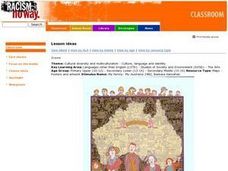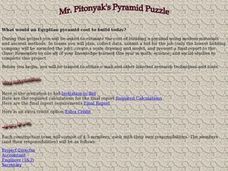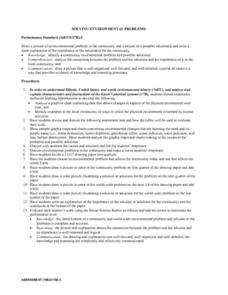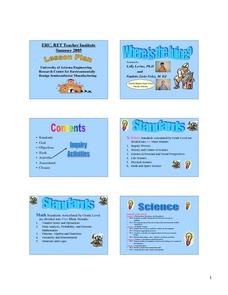Curated OER
Reaching Across Borders In Southern Africa
Students gain a greater understanding of how political borders impact human and environmental development. Then, either individually or as a class, establish a correspondence with a Peace Corps volunteer working in Africa.
Curated OER
EARLY CIVILIZATIONS
Students compare and contrast the monuments of four ancient cultures and draw conclusions about the origins, construction, and purposes of these structures.
Curated OER
Racism No Way
Students explore different cultural influences and their contribution to Australian identities. They reflect on their own backgrounds and making links with their peers, reflect on our heritage. Students view My family- My Australia,...
Curated OER
Westward Expansion
Students explore the Westward Expansion Movement of U.S. history. In this Westward movement lesson plan, students use primary and secondary source documents research personal accounts of those who travelled west during the era....
Curated OER
Mercado Trading at the Marketplace
Middle schoolers comprehend that Mexico is a country. They identify two types of regions in Mexico. Students comprehend that many people in Mexico speak Spanish. They use three Spainsh words. Studnents begin to relate simple words...
Curated OER
The Last Great Race
Third graders identify and discover why the Iditarod race is done each year. They explore the historical significance of the Iditarod. Students also use web sites to research related topics, i.e. diseases (diptheria), geography of...
Curated OER
Introduction to Restoration Lesson
Students explore how pollution and invasive plants disrupt the ecosystem. In this restoration instructional activity students list materials that pollute wetlands, how people can keep them clean and ways in which invasive plants...
Curated OER
Pair the Plants: An Introduction to Scientific Names
Students examine why plants have both common and scientific names, then complete the activity by matching each common plant name with its scientific name. They finish by working in cooperative groups to create an ABC of Plants class book.
Curated OER
Earth: The Food We Eat, The Seeds We Sow
High schoolers explore the importance of seed diversity for cultural and ecological stability/health. They discover what an heirloom seed is and why they are important to conserve.
Curated OER
A Day in the Life of a San Francisco Native Animal
Learners write from an animal's perspective. In this writing lesson students explore the landscape of San Francisco prior to the arrival of the explorers. Learners research animals indigenous to the area.
Curated OER
Mr. Pitonyak's Pyramid Puzzle
Students determine how much it would cost to build a pyramid using modern materials and ancient methods. They design scale drawings, models and submit final cost bids in an attempt to get the job of building a pyramid.
Curated OER
The Hippies vs. Authority
Students, in groups, explore the dynamics between hippies and authority figures and create a T-chart outlining the concerns and arguments of both sides.
Curated OER
THE PLOW
Students create a time line. They research major events and advancements in the development of the plow. They describe and date at least ten major events and advancements in the development of the plow from prehistoric to present day....
Curated OER
Beach Burgers
Twelfth graders develop economic literacy of basic economic problems confronting all societies. Economic decision making, scarcity to make choices, economic confronts, market system, prices, demand curves and supply curves are all covered.
Curated OER
Conservation at a Crossroads Lesson 1: What Is Conservation and Why Does It Matter?
Students explore the concept of conservation. In this conservation lesson, students read articles and primary documents about the Conservation Movement in the United States and compare the movement to today's environmental movements....
Curated OER
Solving Environmental Problems
Students identify a community environmental problem and possible solutions. They analyze the connection between the problem and the solutions and the importance of it to the local community. Students then draw a picture of an...
Curated OER
Burn, Baby Burn (Or Not)
Physics learners apply the concepts of fluid pressure input and output to firefighting. Divide your class into small groups and give them each a few cards that list nozzle type, hose length, hose size, and structure dimensions, They are...
Curated OER
Where Is The Juice?
Students are introduced to the component's of Ohm's Law. In groups, they practice their problem solving skills by reviewing problems solved earlier. They participate in activities that help them gather information on the importance of...
Curated OER
Civilizations of the Americas
Study and compare multiple aspects of both Aztec and Inca civilizations. Young historians explain how each of the empires came to be, and how they were both defeated by the Spanish. The resource starts out as a good lesson, but is...
Curated OER
Children's Literature Across the Curriculum Ideas-Harvey Potter's Balloon Farm
Students read Harvey Potter's Balloon Farm by Jerdine Nolen Harold. They complete a variety of cross-curricular activities surrounding the study of balloons. Included are reading, art, math, science, writing, social studies, and library...
Curated OER
Looking at French Decorative Arts
Students research the history of trade in porcelain wares from Asia and the quest to re-create true hard-paste porcelain in Europe and art in French society. In this French art lesson, students research and discuss the possible...
Curated OER
Maya Math: From Zero to Nineteen
Students explore counting methods of the ancient Maya, and practice identifying Maya number glyphs.
Curated OER
Why Do We Separate Power?
Students investigate the separation of powers that are outlined in the Constitution. The lesson includes essential questions that are used to guide the research. The information is used to increase knowledge of how power is used in...
Curated OER
Family Traditions and Special Times
Second graders recognize that families have a history through discussions with their own family members, identify traditions and how they vary in different families, and create entries in class book about traditions in their families.

























